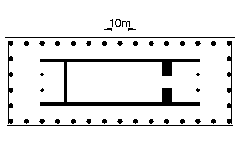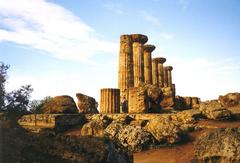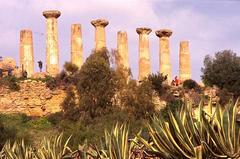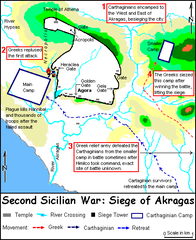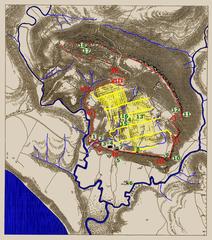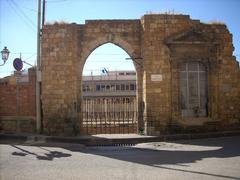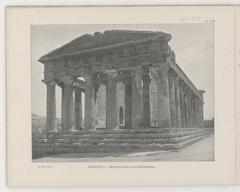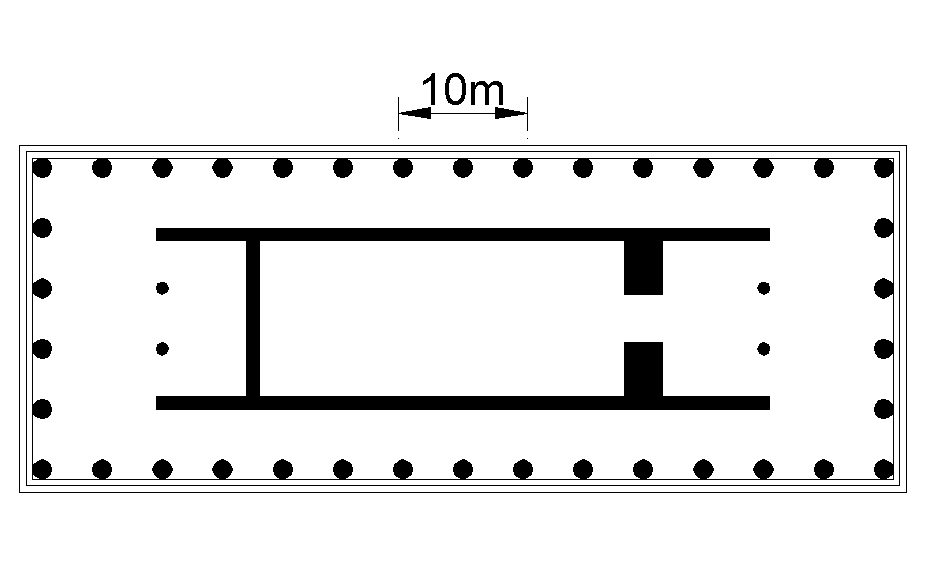
Comprehensive Guide to Visiting Tempio di Ercole, Agrigento, Italy
Date: 19/07/2024
Introduction
The Tempio di Ercole, also known as the Temple of Hercules, stands as a majestic testament to ancient Greek civilization nestled in the Valley of the Temples in Agrigento, Italy. This remarkable structure, dating back to the late 6th century BCE, is one of the oldest and most significant temples in the region. Built during the period when Akragas was a thriving Greek colony, the temple exemplifies the architectural prowess and cultural richness of the era (UNESCO).
The temple’s Doric design, characterized by its sturdy columns and simplistic elegance, reflects the architectural norms of its time. Originally featuring 38 towering columns, the Tempio di Ercole’s grand scale and use of local tufa stone underscore the wealth and influence of Akragas at its zenith (Valley of the Temples Official Site).
Throughout history, the temple has served as a pivotal religious center dedicated to Hercules, a figure revered for his strength and heroic exploits in Greek mythology. Its significance persisted through the Roman period, where the temple continued to be an important site of worship (Ancient History Encyclopedia). Over the centuries, the temple faced decline due to natural disasters and human activities, but restoration efforts in the modern era have helped revive its historical grandeur, attracting thousands of visitors each year (Sicily Tourism).
Table of Contents
- [Origins and Construction](#origins-and-constructionorigins-and-construction)
- [Architectural Features](#architectural-featuresarchitectural-features)
- [Historical Significance](#historical-significancehistorical-significance)
- [Decline and Rediscovery](#decline-and-rediscoverydecline-and-rediscovery)
- [Restoration Efforts](#restoration-effortsrestoration-efforts)
- [Visitor Information](#visitor-informationvisitor-information)
- [Visiting Hours](#visiting-hoursvisiting-hours)
- [Ticket Prices](#ticket-pricesticket-prices)
- [Accessibility](#accessibilityaccessibility)
- [Travel Tips](#travel-tipstravel-tips)
- [FAQ](#faqfaq)
- [Conclusion](#conclusionconclusion)
- [References](#referencesreferences)
Origins and Construction
The Tempio di Ercole, also known as the Temple of Hercules, is one of the most ancient and significant structures in the Valley of the Temples in Agrigento, Sicily. This Doric temple dates back to the late 6th century BCE, around 510 BCE, making it one of the earliest temples constructed in the area. The temple was built during the period when Akragas (the ancient name for Agrigento) was a thriving Greek colony, founded by settlers from Gela and Rhodes in 580 BCE. The construction of the temple is attributed to the efforts of the tyrant Theron, who ruled Akragas from 488 to 472 BCE (UNESCO).
Architectural Features
The Temple of Hercules is a classic example of Doric architecture, characterized by its sturdy and simplistic design. Originally, the temple had 6 columns on the short sides and 15 on the long sides, totaling 38 columns. Each column stood approximately 10 meters high and was fluted with 20 grooves. The temple’s dimensions are approximately 67 meters in length and 25 meters in width, making it one of the largest temples in the Valley of the Temples (Valley of the Temples Official Site).
The temple was constructed using local tufa stone, which was readily available in the region. The use of this material, combined with the temple’s massive scale, reflects the wealth and power of Akragas during its peak. The temple’s interior housed a large cult statue of Hercules, which was a common feature in Greek temples dedicated to gods and heroes.
Historical Significance
The Temple of Hercules holds immense historical significance due to its association with the ancient Greek hero Hercules, known for his strength and numerous mythological exploits. Hercules was a popular deity in the Greek world, and his worship was widespread in Sicily. The temple served as a major religious center for the inhabitants of Akragas, who would have participated in various rituals and ceremonies dedicated to Hercules.
Throughout its history, the temple has witnessed numerous events and changes. During the Roman period, Akragas was renamed Agrigentum, and the temple continued to be an important religious site. The Romans, who admired Greek culture and architecture, preserved and maintained the temple, ensuring its continued use and significance (Ancient History Encyclopedia).
Decline and Rediscovery
The decline of the Temple of Hercules began in the late antiquity period, as the Roman Empire weakened and eventually fell. The temple, like many other ancient structures, suffered from neglect, natural disasters, and human activities. Earthquakes, in particular, caused significant damage to the temple, leading to the collapse of many of its columns and structures.
During the Middle Ages, the temple’s stones were repurposed for other construction projects, further contributing to its deterioration. It wasn’t until the 18th century that the temple was rediscovered by European travelers and scholars, who were fascinated by the remnants of ancient Greek civilization. The first systematic excavations and studies of the temple were conducted in the 19th century, leading to a renewed interest in its preservation and restoration (Sicily Tourism).
Restoration Efforts
In the 20th century, significant efforts were made to restore and preserve the Temple of Hercules. Archaeologists and conservationists worked diligently to stabilize the remaining structures and reconstruct parts of the temple. Today, eight columns on the southern side of the temple have been re-erected, providing visitors with a glimpse of its original grandeur.
The restoration of the Temple of Hercules is an ongoing process, with continuous efforts to protect and maintain this invaluable piece of ancient history. The temple is now part of the Valley of the Temples Archaeological Park, a UNESCO World Heritage Site, which attracts thousands of visitors each year who come to marvel at its historical and architectural significance (UNESCO).
Visitor Information
Visiting Hours
The Temple of Hercules and the Valley of the Temples Archaeological Park are open daily from 8:30 AM to 7:00 PM. During the summer months, the park may extend its hours to accommodate more visitors. It’s always a good idea to check the official website for the most current visiting hours.
Ticket Prices
Ticket prices for the Valley of the Temples Archaeological Park vary depending on the season and any special events. As of the latest update, general admission tickets are approximately €12 for adults, with discounts available for students, seniors, and groups. Children under the age of 18 can enter free of charge. Combo tickets that include admission to the park and the nearby Archaeological Museum are also available.
Accessibility
The Valley of the Temples is committed to making the site accessible to all visitors. There are designated pathways and facilities for individuals with mobility issues. However, due to the nature of the ancient site, some areas may be challenging to navigate. It is recommended to contact the park in advance for detailed accessibility information and assistance.
Travel Tips
- Guided Tours: Consider booking a guided tour to gain deeper insights into the history and significance of the Temple of Hercules and the Valley of the Temples. Many tours are available in multiple languages.
- Best Time to Visit: Early morning or late afternoon visits are recommended to avoid the midday heat and large crowds, especially during the summer months.
- Nearby Attractions: Don’t miss other historic sites in Agrigento, such as the Temple of Concordia, the Archaeological Museum, and the Church of San Nicola.
- Photography: The Temple of Hercules offers stunning photo opportunities, particularly during sunrise and sunset. Be mindful of other visitors and respect the site’s rules regarding photography.
- Special Events: Check the park’s schedule for special events, including reenactments, concerts, and the annual Festival of the Almond Blossom, which features traditional music, dance, and performances with the Temple of Hercules as a picturesque backdrop (Agrigento Tourism).
FAQ
Q: What are the visiting hours for the Temple of Hercules? A: The Temple of Hercules is open daily from 8:30 AM to 7:00 PM. Check the official website for any updates or changes to the schedule.
Q: How much are tickets to visit the Temple of Hercules? A: General admission tickets are approximately €12 for adults, with discounts for students, seniors, and groups. Children under 18 can enter for free. Combo tickets with the Archaeological Museum are also available.
Q: Is the Temple of Hercules accessible to visitors with mobility issues? A: The park has designated pathways and facilities for individuals with mobility issues, but some areas may be challenging. Contact the park in advance for detailed accessibility information.
Conclusion
The history of the Temple of Hercules in Agrigento is a fascinating journey through time, from its origins in ancient Greece to its rediscovery and restoration in the modern era. As one of the oldest and most significant temples in the Valley of the Temples, it offers invaluable insights into the religious, cultural, and architectural achievements of ancient civilizations. Visitors to the temple can not only appreciate its historical importance but also experience the enduring legacy of Hercules and the ancient world.
For more information, download the mobile app Audiala, check out other related posts, or follow us on social media for more updates.
References
- Exploring the Temple of Hercules in Agrigento - History, Visiting Hours, and Tickets, 2024, UNESCO
- Exploring the Temple of Hercules in Agrigento - History, Visiting Hours, and Tickets, 2024, Valley of the Temples Official Site
- Exploring the Temple of Hercules in Agrigento - History, Visiting Hours, and Tickets, 2024, Ancient History Encyclopedia
- Exploring the Temple of Hercules in Agrigento - History, Visiting Hours, and Tickets, 2024, Sicily Tourism
